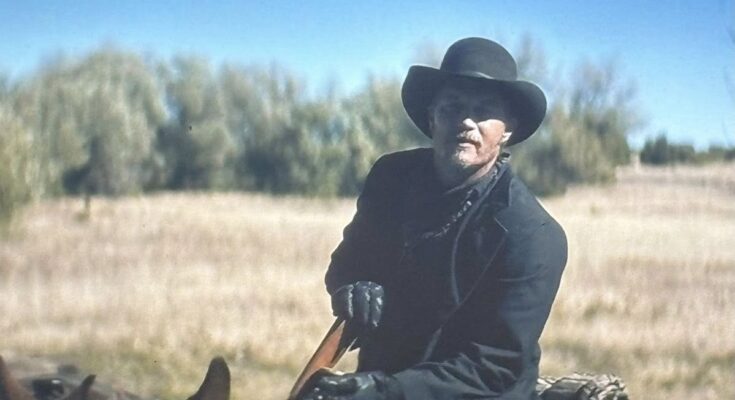“Cowboy Travis Shines as Unforgettable Antagonist in Stunning New Western Honoring Halyna Hutchins’ Final Cinematic Masterpiece”
The Western genre has always held a special place in cinema history, evoking images of rugged landscapes, stoic heroes, and morally complex characters whose actions define the thin line between right and wrong. In this latest release, audiences are treated to a film that does more than just revisit classic Western tropes—it elevates them, delivering an emotionally resonant, visually stunning experience anchored by a performance that is impossible to forget. At the heart of this cinematic triumph is Travis, whose portrayal of the antagonist in the film proves once again that his talent transcends typecasting and conventional expectations.
For viewers who may have been unaware of Travis’ involvement before seeing the film, the revelation is nothing short of a delightful surprise. From the moment he appears on screen, he commands attention—not in the traditional heroic sense, but through a magnetic presence that makes every scene he occupies feel charged with tension and intrigue. Unlike conventional antagonists who may come across as one-dimensional or purely villainous, Travis’ character is layered with complexity. He is at once charming, unpredictable, and at times painfully human, creating a tension that keeps audiences invested in his every decision and interaction. It is a testament to his skill that viewers may find themselves rooting for a character they know stands in opposition to the protagonists, a rare achievement in any film, let alone a genre as familiar as the Western.
The film itself is a visual feast. Every frame has been crafted with meticulous attention to detail, from the sweeping desert vistas to the intimate, shadow-laden interiors where critical confrontations unfold. Cinematographer Halyna Hutchins, whose tragic passing on set sent shockwaves through the industry, leaves a final legacy that is impossible to ignore. Her work captures both the grandeur of the Western landscape and the subtle emotional nuances of the characters, creating a cinematic texture that feels immersive and profoundly human. Hutchins’ dedication to her craft is evident in every shot, from the way light falls across the rugged terrain to the careful composition that frames moments of tension, reflection, and quiet vulnerability. It is clear why she was so proud of this project, and why her family has encouraged audiences to witness her final work on the big screen or through streaming platforms.
Initially, some potential viewers may have hesitated to see the film due to the circumstances surrounding its production. The tragedy that befell Hutchins could understandably cast a shadow over the movie’s reception. Yet, the decision to honor her vision and celebrate her artistry is not only admirable but essential to fully appreciating the impact of the film. By choosing to engage with the work, audiences participate in a collective acknowledgment of her talent and dedication, allowing the story she helped craft to live on in the way she intended. It is both a respectful tribute and an opportunity to experience a truly exceptional piece of cinema.
Beyond its technical brilliance and visual elegance, the film succeeds because of its storytelling. The narrative is layered, weaving together elements of classic Western themes—revenge, survival, loyalty, and moral ambiguity—while also introducing modern sensibilities that make the story feel fresh and relevant. Each character is given space to breathe and develop, creating a dynamic interplay that heightens the stakes and draws viewers into the world on screen. Travis’ character, in particular, serves as a focal point for these themes. His presence challenges the audience’s assumptions about morality and heroism, forcing them to confront the complexities of human nature. In doing so, he elevates the film beyond a conventional genre piece into something that resonates on a deeper emotional level.
The emotional core of the film is further strengthened by the relationships and conflicts between its characters. Interactions are layered with tension, subtext, and occasional moments of unexpected tenderness. These relationships are not merely plot devices; they are integral to the storytelling, shaping the characters’ motivations and the trajectory of the narrative. Travis’ portrayal adds a compelling dimension to these dynamics, as his character’s unpredictable nature creates constant uncertainty, prompting both the protagonists and the audience to reconsider their assumptions at every turn. It is a performance that lingers long after the credits roll, a testament to the actor’s ability to infuse even morally ambiguous roles with humanity and charisma.
Streaming availability in the U.S. on platforms such as Fandango, Apple+, and Prime ensures that the film can reach a wide audience, allowing more viewers to engage with this remarkable piece of work. The accessibility of streaming provides an opportunity for those who may have missed its theatrical release to experience the artistry and emotional weight that define the film. Yet, whether viewed on a large screen or at home, the impact of the cinematography, performances, and storytelling remains undeniable. Hutchins’ visual legacy shines through in every frame, and Travis’ unforgettable performance anchors the narrative, ensuring that the film leaves a lasting impression.
It is also worth noting the broader significance of the film within the Western genre. In a cinematic landscape that often prioritizes spectacle over substance, this movie stands out for its commitment to character, emotion, and visual storytelling. It reminds audiences why the Western remains a fertile ground for exploring human nature, morality, and the complex interplay between individuals and the environments they inhabit. By combining technical mastery, narrative depth, and compelling performances, the film not only honors the traditions of the genre but also pushes its boundaries, demonstrating that Westerns can continue to evolve and resonate with contemporary audiences.
In conclusion, the latest Western featuring Travis as a compelling antagonist is a must-watch for both fans of the genre and cinema enthusiasts alike. It is a film that balances visual splendor with emotional depth, anchored by a performance that is both magnetic and unforgettable. By honoring the artistry of Halyna Hutchins, the film also serves as a poignant reminder of the power of cinema to transcend tragedy, celebrate talent, and leave a lasting impact on viewers. Whether it is the allure of Travis’ nuanced portrayal, the breathtaking cinematography, or the layered storytelling, there is something in this film that speaks to everyone. For those in the U.S., streaming options on Fandango, Apple+, and Prime make it accessible and easy to experience. This is more than just a Western; it is a tribute, a work of art, and a testament to the enduring power of storytelling on screen.



